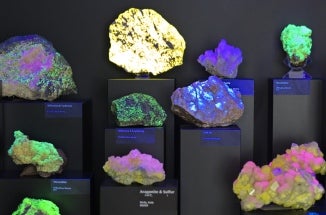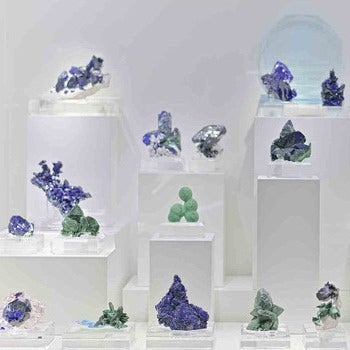
Mexican Minerals Added to UT Collection
- May 7, 2025
A unique collection of Mexican ore minerals — including an award-winning, vibrant blue azurite and stacked spheres of malachite that resemble a green rabbit — are now on public display at the Hamman Gem and Mineral Gallery at The University of Texas at Austin.
The selection recently joined the gem and mineral collection in the Jackson School of Geosciences, thanks to a generous donation from Eric Long and spouse Tracy Walsh.

“These minerals are not trimmed, they’re not polished. This is what nature does on its own, forming these crystals, these beautiful things,” said Long.
Most of the new additions hail from the Milpillas Mine of Sonora, Mexico, offering unique insight into the geology of a copper mine. The mine produced some of the best specimens of azurite and malachite in the world before operations were indefinitely suspended in 2020 after 13 years of operation.
One of the collection’s blue azurite specimens is displayed alongside a trophy, an award from the 2022 Miguel Romero Memorial Award winner for the best Mexican mineral at the world-renowned Tucson Gem and Mineral Show.

“Azurite is a geology student’s mineral. We teach it in every mineral class,” said Kenneth Befus, associate professor of practice at the Department of Earth and Planetary Sciences and the curator of the school’s gem and mineral collections. “It’s an amazing blue color, and since it’s a copper mineral, it matters to the global economy. And we now have 15 world-class azurites.”
Long and Walsh share a longstanding interest in geoscience, having collected minerals for more than a decade. They’ve previously donated minerals to other universities but decided to bestow the Mexican ore minerals to UT for a few reasons. Although the collection attracted interest from several university and national collections, the pair wanted to pay tribute to the historical connection between Texas and Mexico — and beyond that, foster conversations about mining at a university known for its energy research.
For more information, check out the Texas Geosciences News Page.
